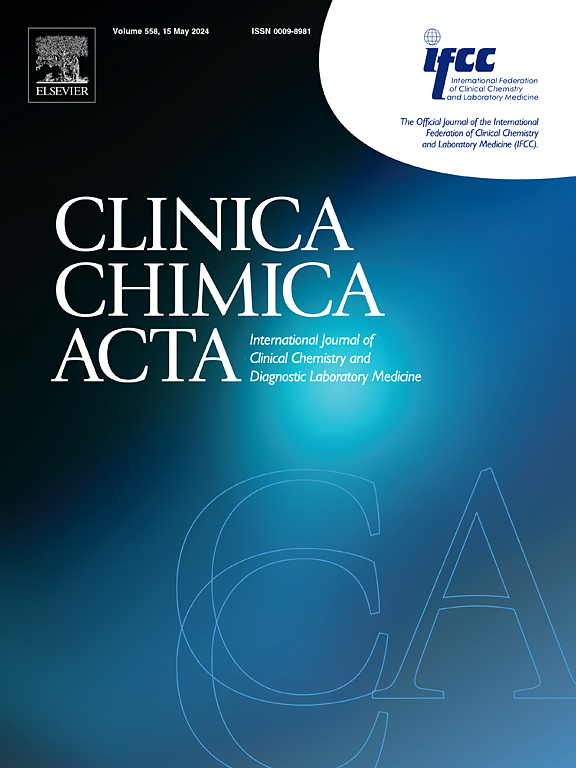UPLC-Q-TOF/MS-based urine metabolomics for the diagnosis and staging of bladder cancer
IF 3.2
3区 医学
Q2 MEDICAL LABORATORY TECHNOLOGY
引用次数: 0
Abstract
Background
Bladder cancer (BC) is a common malignant tumour of the urinary system. Currently, the gold standard for diagnosing BC is cystoscopy, but it is an invasive examination that can lead to a certain psychological burden on the patient. In this study, we aimed to identify non-invasive potential metabolic biomarkers that could improve the diagnostic accuracy of bladder cancer.
Methods
Urine from 30 healthy people and 50 BC patients, including 40 non-muscle-invasive bladder cancer (NMIBC) patients and 10 muscle-invasive bladder cancer (MIBC) patients, were analyzed by liquid chromatography coupled with mass spectrometry to identify potential diagnostic metabolites. Binary Logistic regression was used to construct biomarker panels. Correlation analysis and construction of compound-reaction-enzyme-gene network were also performed to explore the possible mechanisms of BC development.
Results
Twenty-six metabolites were identified for differentiating BC patients from healthy controls, and eight metabolites were identified for differentiating NMIBC patients form MIBC patients. The biomarker panel consisting of urate, 4-Androstene-3α, 17β-diol and 3-Indoxyl sulfate can distinguish well between BC patients and healthy controls, with an area under the ROC curve (AUC) value of 0.983. And the biomarker panel consisting of L-Octanoylcarnitine, γ-Glutamylleucine, and heptanoylcarnitine for distinguishing NMIBC patients from MIBC patients had an AUC value of 0.941.
Conclusions
The diagnostic capability of the biomarker panels are superior to that of any single potential biomarker. This panel significantly benefits bladder cancer diagnostics and reveals insight into bladder cancer pathogenesis.
基于 UPLC-Q-TOF/MS 的尿液代谢组学用于膀胱癌的诊断和分期。
背景:膀胱癌(BC)是泌尿系统常见的恶性肿瘤:膀胱癌(BC)是泌尿系统常见的恶性肿瘤。目前,诊断膀胱癌的金标准是膀胱镜检查,但这是一种侵入性检查,会给患者带来一定的心理负担。在这项研究中,我们旨在找出可提高膀胱癌诊断准确性的非侵入性潜在代谢生物标志物:方法:采用液相色谱-质谱联用技术对 30 名健康人和 50 名膀胱癌患者(包括 40 名非肌层浸润性膀胱癌(NMIBC)患者和 10 名肌层浸润性膀胱癌(MIBC)患者)的尿液进行分析,以确定潜在的诊断代谢物。二元逻辑回归用于构建生物标记物面板。此外,还进行了相关性分析并构建了化合物-反应-酶-基因网络,以探索 BC 的可能发展机制:结果:共鉴定出26种代谢物可用于区分BC患者和健康对照组,8种代谢物可用于区分NMIBC患者和MIBC患者。由尿酸盐、4-雄烯-3α,17β-二醇和 3-吲哚硫酸酯组成的生物标记物面板能很好地区分 BC 患者和健康对照组,其 ROC 曲线下面积(AUC)值为 0.983。而由 L-辛酰肉碱、γ-谷氨酰亮氨酸和庚酰肉碱组成的生物标记物面板用于区分 NMIBC 患者和 MIBC 患者的 AUC 值为 0.941:生物标记物面板的诊断能力优于任何单一的潜在生物标记物。该小组对膀胱癌诊断大有裨益,并能揭示膀胱癌的发病机制。
本文章由计算机程序翻译,如有差异,请以英文原文为准。
求助全文
约1分钟内获得全文
求助全文
来源期刊

Clinica Chimica Acta
医学-医学实验技术
CiteScore
10.10
自引率
2.00%
发文量
1268
审稿时长
23 days
期刊介绍:
The Official Journal of the International Federation of Clinical Chemistry and Laboratory Medicine (IFCC)
Clinica Chimica Acta is a high-quality journal which publishes original Research Communications in the field of clinical chemistry and laboratory medicine, defined as the diagnostic application of chemistry, biochemistry, immunochemistry, biochemical aspects of hematology, toxicology, and molecular biology to the study of human disease in body fluids and cells.
The objective of the journal is to publish novel information leading to a better understanding of biological mechanisms of human diseases, their prevention, diagnosis, and patient management. Reports of an applied clinical character are also welcome. Papers concerned with normal metabolic processes or with constituents of normal cells or body fluids, such as reports of experimental or clinical studies in animals, are only considered when they are clearly and directly relevant to human disease. Evaluation of commercial products have a low priority for publication, unless they are novel or represent a technological breakthrough. Studies dealing with effects of drugs and natural products and studies dealing with the redox status in various diseases are not within the journal''s scope. Development and evaluation of novel analytical methodologies where applicable to diagnostic clinical chemistry and laboratory medicine, including point-of-care testing, and topics on laboratory management and informatics will also be considered. Studies focused on emerging diagnostic technologies and (big) data analysis procedures including digitalization, mobile Health, and artificial Intelligence applied to Laboratory Medicine are also of interest.
 求助内容:
求助内容: 应助结果提醒方式:
应助结果提醒方式:


